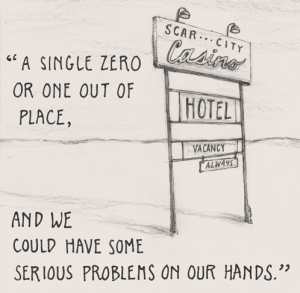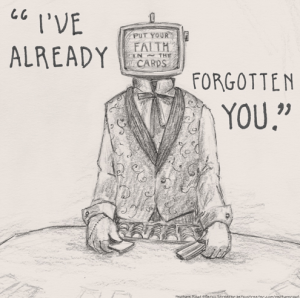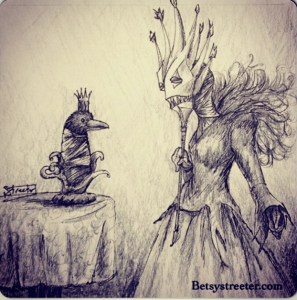Betsy Streeter is Californian science fiction writer, artist, and comic creator. She is the perfect storm of creativity and I can’t urge you enough to check out her ongoing webcomic Neptune Road. This is a science fiction mystery set on Neptune, an experimental colonization effort that has met with repeated complications. The planet is still not able to support human life, and the inhabitants are surviving off of finite sources of air and sunlight. The cast of characters each have their own reasons for being there, and the story keeps getting better.
Betsy agreed to an interview with WWAC, and here are her inspiring answers
When did you first begin drawing? How about writing? What motivates you to continue creating art and stories?
When I was five or so, my dad would bring home stacks of computer paper from work and I would cover it all with drawings by the next day, when he would bring home another stack. I also drew on things that were not meant to be drawn on, of course. Like mascara on the bookshelf. This led to drawing all over my school stuff and other things, even some graffiti. Never spray paint graffiti in a basement. Not enough ventilation.
Writing happened along the way; it snuck in there. In order to explain my ideas, I had to write. Also, I am a voracious reader, so writing feels like hanging out with all these other writers I admire.
By the way, single-panel cartooning will really hone your writing skills. You have to put in exactly what needs to be there, and nothing else. I did a feature called “Brainwaves” for a long time, it added up to over 2,000 panels.
I make art and write because any day I make something feels like a day that was worth living. I realize this is goofy and corny and might induce eye rolling.
Many of your pictures are a mix of fantasy and the modern, done with a realistic, detailed approach. What can you tell us about the process of developing this style of illustration?
Sometimes when you look at an old photograph, something is off. Like, the facial expression is weird, or there’s some smudge in the background, or you realize it’s actually a dead person, or one of those portraits of a child where the mother is holding on to them while wearing a tablecloth or something over her head and pretending not to be there. These are clues to just how weird and crazy people were back then, just like now. I mean, what is going on inside the heads of these people in uniform holding bayonets or women standing there in huge bustles? Is that her only nice dress? How long did it take to get her hair like that? What was the weather like that day? I obsess over these questions. This leads to ideas and embellishments. And, heads of birds.
There’s something about an old photo that to me is more real than a modern one.
I have always had this layered pencil and ink type of style. It’s like I build a drawing. I’ll go in with pencil, and then ink, and pencil again. I fall in love with the drawing as I go.
 Neptune Road utilizes a fresh form of storytelling, with one gorgeous image to kick off each section of text. What was your main inspiration in using this method of story-telling? Also, speaking of inspiration, what inspired you to write this story?
Neptune Road utilizes a fresh form of storytelling, with one gorgeous image to kick off each section of text. What was your main inspiration in using this method of story-telling? Also, speaking of inspiration, what inspired you to write this story?
Thank you for using the word “gorgeous!”
Neptune Road mashes together aspects of flash fiction and comic panels. It started out a more standard comic format, but I wanted it to be delightful to read on a phone during your commute (on a train or bus, please), or in line at the bank, or wherever. So you pop in there and get a gift of an image, and then about 300 words or so. You can read as many or as few of these as you want.
Part of the inspiration comes from big stories and series such as Battlestar Galactica, Star Trek, Doctor Who, etc. and how you can pick up a piece here, another there, hear part of something, and the story kind of pixelates together for you. Maybe you talk to a friend about an episode, or you watch it out of order. The characters are still fascinating and fun to hear and look at.
I’m experimenting with the comic medium, looking for new ways to make comics and tell stories mixing visuals and words. It’s also fun that if you only look at the Neptune Road pictures without the text, you’ll get a different spin on the story or a different story altogether.
That’s the format part.
In terms of the story, I wanted to create a world that was far enough afield to be science fiction, but close enough that the characters would have everyday flaws and agendas and struggles that people can relate to. I loved the idea of humans populating a new world, but not Mars. A reformulated gas giant. One that was pretty messed up from the get-go. Nothing is tidy in this story.
The name “Neptune Road” comes from a road in Boston that slowly got consumed by an airport. Eventually the last house got pulled down and it was gone. It’s a case of man-made things attacking each other. And that’s what it’s about, the messiness but also resilience of making it up as you go.
Your first young adult novel, Silverwood, will be coming out in 2015. What can you tell us about the process of publishing a full length novel as opposed to an online format?
I’m obsessed with my characters and doing right by them — this is true for any length of story. The characters demand to be written, whether in short or long form. Sometimes I think they are souls that just haven’t gotten bodies.
The characters in Silverwood have a whole lot to say, and all these relationships and history. The proto-Silverwood was this series of drawings I did with no words where I started with a figure in a chair, and had it get up and go out the door and saw what might happen one drawing at a time. This ended up being a series I called “The Lost Queen.” The book grew out of that, among other things.
Constructing a novel is a big exercise in continuity and pacing. I write each scene in its own folder, again like these pixels that are going to stick together. When I start in on a scene I know where I’m trying to get to, an interaction or situation or image. I go after those, and put them in order, and keep filling in more chapters in-between. I think about it like making a movie using words.

Science Fiction is such an important literary genre. Beyond making for great stories, it’s also an effective way to get in peoples’ heads and show them new scientific possibilities and theories. What Science Fiction works have had the biggest impact on you?
Star Trek is huge because of its ensemble cast and big ideas about how our species could do better. The Matrix for questioning our perception of reality. Blade Runner for flawed characters.
Westerns have been a big influence. I used to watch spaghetti Westerns and Clint Eastwood movies all the time as a kid. I loved the premise of these people with all their different agendas thrown into the unforgiving environment of the frontier. At its root, Neptune Road is a Western. All these misfits striking out into uncertainty and then making it up as they go – and having to deal with each other.
Oh! And monster movies. They are like sporting events, with comebacks and heroic efforts and the spectators all agitated over what is going to happen. I used to watch those when I wasn’t watching Pale Rider. Mo-ther-aaaaaaa!
What are the main scientific themes you work to communicate to your readers?
The notion that everything is invented by someone or something, even trees. How new technologies and ideas are collisions of old ones. The notion of passing forward of the hard work of making stuff up and trying stuff out. How nothing is tidy and mistakes are what makes life what it is. Unintended consequences. Resilience. Reinvention.
Your website includes a section of biographies of Great Women. Each woman included so far is undeniably awesome. Do you have other women in mind to add to the roster?
I do! Margaret Meade is coming up. I encountered a display on her at the Museum of Natural History in New York. Martina Navratilova, a longtime idol. I am open for suggestions, too. Someone suggested Helen Keller, so I drew her.
What can you share with us about your upcoming works?
The future of Neptune Road will definitely include non-human species, since if you were visiting from another star system you’d reach Neptune before Earth anyway.
I’ve got the second Silverwood book worked out in outline, but I want to interact with readers of the first book before nailing it down and respond to what connects most for people.
As Neptune Road develops, I am really looking forward to hearing from readers, getting their reactions, seeing what interests them most and what ideas they have about it. Anything from story to characters to how I am formatting and publishing it. And I love answering questions about it as well – where is this plot line going? Why did that character do that? I love that aspect of publishing and I hope folks will pipe up and let me know what they are thinking.
And I hope to do the same with Silverwood! Maybe you will see me flailing through a bookstore in your area. I hope so!

